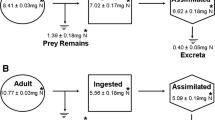Summary
An wolf spider,Lycosa pseudoannulata, collected from the field were reared in test tubes supplied with fruit flies as the food, and the number and weight of fruit flies killed per unit time and the weight of residuum of killed flies were recorded. When the cumulative number of flies killed by a spider was plotted against time after the beginning of food supply, the angle of the curve obtained decreased gradually until a constant value. In this time, it seems that the gut of spider had saturated with food and the increase rate of number of flies killed reflects the rate of food disappeared from gut by assimilation and egestion. The amount of ingestion was obtained by subtracting the weight of residuum and the gain of live weight of the spider from the weight of killed flies. After the gut has saturated, the amount of food remained in the gut is considered to be equal to the capacity of gut, which is an essential factor in the study of predation. The amount of food disappearance from gut was also estimated.
There was a linear relationship between the log body weight of spiders and the log capacity of gut. The linear relationship was also seen between the log total amount of ingestion and the log total amount of food disappeared from gut.
Similar content being viewed by others

References
Bilsing, S. W. (1920) Quantitative studies in the food of spiders.Ohio J. Sci.20: 215–260.
Bonnet, P. (1930) La mue, l'autotomie et la régénération chez les araignées, avec une étude des Dolomedès d'Europe.Bull. Soc. Hist. Nat. Toulouse59: 237–700.
Chant, D. A. (1956) Predacious spiders in orchards in south-eastern England.J. Hort. Sci.31: 35–46.
Haynes, D. L. andP. Sisojeviċ (1966) Predatory behavior, ofPhilodromus rufusWalekenaer (Araneae: Thomisidae).Can. Ent.98: 113–133.
Holling, C. S. (1963) An experimental component analysis of population processes.Mem. Ent. Soc. Can. No.32: 22–32.
Kobayashi, T. (1961)The effect of insecticidal applications to the rice stem borer on the leafhopper populations. (Special reprot of forecasting insect pests, No. 6), Min. Agric. For., Tokyo. (In Japanese).
Miyashita, K. (1968a) Quantitative feeding biology ofLycosa T-insignitaBoes etStr. (Araneae; Lycosidae).Bull. Nat. Inst. Agric. Sci., Ser. C22: 329–344.
Miyashita, K. (1968b) Growth and development ofLycosa T-insignitaBoes, etStr. (Araneae: Lycosidae) under different feeding conditions.Appl. Ent. Zool.3: 81–88.
Turnbull, A. L. (1962) Quantitative studies of the food ofLinyphia triangularisClerck (Araneae: Linyphiidae).Can. Ent.94: 1233–1249.
Author information
Authors and Affiliations
Rights and permissions
About this article
Cite this article
Nakamura, K. The ingestion in wolf spiders I. Capacity of gut ofLycosa pseudoannulata . Res Popul Ecol 10, 45–53 (1968). https://doi.org/10.1007/BF02514733
Issue Date:
DOI: https://doi.org/10.1007/BF02514733



